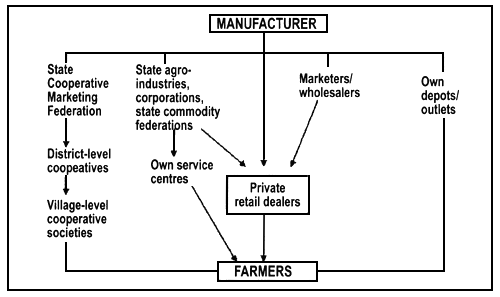In 1944, the Government of India established the “Central Fertilizer Pool” as the official agency for the distribution of all available fertilizers at fair prices throughout the country. All fertilizers, whether domestically produced or imported, were pooled together and distributed through state agencies. In 1966, manufacturers were allowed to market 50 percent of their production. By 1969, the domestic manufacturers had been given complete freedom in marketing. However, this was short-lived. Fertilizer shortages in the early 1970s led the Government to pass the Fertilizer Movement Control Order in 1973, which brought the distribution of fertilizers under government control.
In the mid-1970s, the supply and distribution of fertilizers were regulated under the Essential Commodities Act (ECA). Manufacturers were allocated a quantity of fertilizers in different states according to a supply plan. All the fertilizers were distributed by the manufacturers according to their ECA allocation during the two cropping seasons, kharif and rabi. This system continued up to August 1992. Thereafter, all P and K fertilizers were decontrolled. AS, CAN and ammonium chloride (ACL) were also decontrolled. All these fertilizers were free from distribution control. Only urea continued to remain under control.
With effect from 1 April 2003, the Government implemented the “New Fertilizer Policy”, which allowed urea manufacturers to market initially 25 percent and subsequently 50 percent of their production outside the purview of distribution control. This practice continues today. Urea manufacturers can now market 50 percent of their production as they wish.
The total quantity of fertilizer materials distributed annually increased from 0.3 million tonnes in 1951 to 34.9 million tonnes in 2003/04. This large volume of fertilizer is distributed through a well-developed marketing network spread throughout the country. Cooperatives supply almost 35 percent of the total quantity available from domestic production and importation. Private channels distribute the balance (65 percent). As on 31 March 2004, the total number of sale points was 282 468. Of these, 77 percent were privately owned and 23 percent were in cooperatives and other institutional channels.
FIGURE 5
Fertilizer marketing and distribution channels

Currently, about 75 percent of the total quantity of fertilizer is moved by rail and the remaining 25 percent by road. The average distance of fertilizers moved by rail is about 850 km. However, within a radius of 200 – 250 km from the plant, most of the fertilizer materials are moved by road. The economics of movement favours road transportation up to this distance.
Figure 5 shows the present system of fertilizer marketing and distribution is presented. Indigenous fertilizers are distributed through institutional channels (cooperative societies, agro-industry corporations, state commodity federations, etc.) and private trade. The cooperative marketing structure varies from state to state (two to four tiers). Handling agents distribute imported urea. State agencies and domestic manufacturers distribute imported DAP and complex fertilizers, MOP and SOP.
The marketing cost of urea is about Rs 1 000/tonne. Of this, freight accounts for 50 – 55 percent, the distribution margin accounts for 18 percent and handling and storage for 10 percent (Figure 6).
While fertilizer production is continuous throughout the year, its use is seasonal. In India, there are two main cropping seasons: (i) kharif (April–September); and (ii) rabi (October–March). Fertilizers are stored before the onset of each season. Consumption is characterized by a peak period followed by lean spells. Therefore, storage is an important factor in fertilizer marketing and distribution. There are about 2 060 central and state warehouses with an aggregate capacity of 30.1 million tonnes. In addition, the Food Corporation of India has a storage capacity of 23.95 million tonnes. The cooperatives have about 65 970 godowns with a capacity of about 14.12 million tonnes. These godowns are used for storage of foodgrains, fertilizer and other commodities.
FIGURE 6
Share of various components in marketing cost of urea

Most farmers cannot afford to purchase fertilizers on a cash basis. Similarly, not every dealer can pay cash for fertilizers. Therefore, credit plays an important role in fertilizer distribution and use. Generally, two types of credit are available in the fertilizer sector for fertilizer distribution and use. One type is distribution credit, which a dealer uses for buying fertilizers from the manufacturer or wholesaler. The second type is production credit, which a farmer uses for purchasing inputs, of which fertilizer is the major one. Various agencies provide credit to the agriculture sector in different forms. These include cooperative banks, regional rural banks, commercial banks and other agencies. Table 21 shows the credit flow by type of agency for agricultural and allied activities from 2000/01 to 2003/04.
Table 21
Credit flow by type of agency for agriculture and allied activities
| Agency | 2000/01 | 2001/02 | 2002/03 | 2003/04 |
| (Rs thousand million) | ||||
| Commercial banks | 278.07 | 335.87 | 397.74 | 438.40 |
| Cooperative banks | 207.18 | 235.24 | 236.36 | 300.80 |
| Regional rural banks | 42.20 | 48.54 | 60.70 | 60.80 |
| Other agencies | 0.82 | 0.80 | 0.80 | - |
| Total | 528.27 | 620.45 | 695.60 | 800.00 |
Kisan (farmer) credit cards (KCCs) were launched in 1998 to facilitate access by farmers to production credit. These credit cards are issued by 27 commercial banks, about 200 regional rural banks and almost 4 000 cooperative banks. Nine states have issued more than a million cards so far.